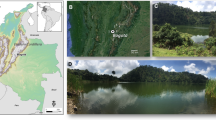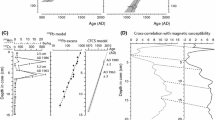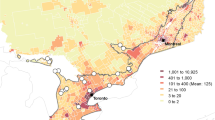Abstract
We conducted a paleolimnological study to examine how changes in human activity interacted with climate to influence productivity and biodiversity over the past millennium in oligotrophic Lake Atnsjøen, SE Norway. The study included analyses of sediment geochemistry, subfossil diatoms and cladocerans, and macrofossils. Results were compared with the historical record of human activities in the catchment, pollen analysis and paleoclimate inferences from the lake. During the first 750 years of the record (1000–1750 CE), a time of relatively low human activity, lake productivity and biodiversity were strongly related to climate. During the Little Ice Age (1550–1800 CE), lake productivity and diatom diversity were constrained by cold climate. A century of climate warming (1780–1880 CE) initiated an increase in productivity. Accelerated human settlement after 1850 CE, however, had an even stronger impact on productivity, mediated by increased agriculture and/or forestry, which led to greater nutrient loading of the lake. Similarly, diatoms in the lake responded to the rise in temperature, but increasing human activity also had a moderate impact on the diatom community, which displayed weak signs of nutrient enrichment. From 1980 to 1990 CE onwards, lake productivity declined as a consequence of a recent decrease in human activity and changing land use. The human-induced increase in lake productivity starting ca. 1850 CE propagated through the food web and increased consumer productivity, as reflected by greater accumulation rates of cladocerans, trichopterans and turbellarians. The cladoceran community was likely under top-down control of fish, as indicated by changes in size structure and diversity. Our study showed that increasing human activity during the settlement period had a stronger impact on lake productivity than did climate. Furthermore, the slight human-mediated increase in nutrient loading had different impacts on productivity and biodiversity in the study lake. This study demonstrates that even relatively small changes in human activities in watersheds can have measurable impacts on nutrient-poor lakes.





Similar content being viewed by others
References
Alric B, Jenny J-P, Berthon V, Arnaud F, Pignol C, Reyss J-L, Sabatier P, Perga M-E (2013) Local forcings affect lake zooplankton vulnerability and response to climate warming. Ecology 94:2767–2780
Anderson NJ, Renberg I, Segerstrom U (1995) Diatom production responses to the development of early agriculture in a boreal forest lake-catchment (Kassjon, Northern Sweden). J Ecol 1995:809–822
Bækkelund B, Kalvatn SJ (1998) Bygdebok for Folldal bind VI. Folldal verks historie ca 1745–1993. [Local history book for Folldal volume VI. The history of Folldal mine approximately 1745–1993.]. Folldal bygdeboknemnd, Folldal, p 308
Bao R, Hernandez A, Saez A, Giralt S, Prego R, Pueyo JJ, Moreno A, Valero-Garces BL (2015) Climatic and lacustrine morphometric controls of diatom paleoproductivity in a tropical Andean lake. Quat Sci Rev 129:96–110
Battarbee RW (1986) Diatom analysis. In: Berglund BE (ed) Handbook of Holocene palaeoecology and palaeohydrology. Wiley, Chichester, pp 527–570
Berthon V, Alric B, Rimet F, Perga ME (2014) Sensitivity and responses of diatoms to climate warming in lakes heavily influenced by humans. Freshw Biol 59:1755–1767
Bigler C, von Gunten L, Lotter AF, Hausmann S, Blass A, Ohlendorf C, Sturm M (2007) Quantifying human-induced eutrophication in Swiss mountain lakes since AD 1800 using diatoms. Holocene 17:1141–1154
Birks HH (2007) Plant macrofossil introduction. In: Elias SA (ed) Encyclopedia of quaternary science. Elsevier, Amsterdam, pp 2266–2288
Brænd B (1989) Sollia 1. Eldre generell historie, garder og slekter i Øverdalen skolekrets [Sollia 1. Older general history, farms and families in Øverdalen school district]. Stor-Elvdal kommune, Koppang, p 485
Brænd B (2007) Sollia 2. Generell historie 1862–1945, garder i statsallmenningen og slekter fra Setningssjøen til Holtet i Atnbrua skolekrets [Sollia 2. General history 1862–1945, farms in the state community and families from Lake Setningssjøen to Holtet in Atnbrua school district]. Stor-Elvdal kommune, Koppang, p 414
Brænd B (2009) Sollia 3. Generell historie etter 1945, garder og slekter i Atnelien i Atnbrua skolekrets [Sollia 3. General history after 1945, farms and families in Atnelien in Atnbrua school district]. Stor-Elvdal kommune, Koppang, p 383
Bragée P, Choudhary P, Routh J, Boyle JF, Hammarlund D (2013) Lake ecosystem responses to catchment disturbance and airborne pollution: an 800-year perspective in southern Sweden. J Paleolim 50:545–560
Brooks JL, Dodson SI (1965) Predation, body size, and composition of plankton. Science 150:28–35
Callicott JB, Crowder LB, Mumford K (1999) Current normative concepts in conservation. Conserv Biol 13:22–35
Cao YM, Zhang EL, Langdon PG, Liu EF, Shen J (2014) Chironomid-inferred environmental change over the past 1400 years in the shallow, eutrophic Taibai Lake (south-east China): Separating impacts of climate and human activity. Holocene 24:581–590
Chen GJ, Dalton C, Leira M, Taylor D (2008) Diatom-based total phosphorus (TP) and pH transfer functions for the Irish Ecoregion. J Paleolimnol 40:143–163
Clark BJ, Paterson AM, Jeziorski A, Kelsey S (2010) Assessing variability in total phosphorus measurements in Ontario lakes. Lake Reservoir Manag 26:63–72
Colby P, Spangler G, Hurley D, McCombie A (1972) Effects of eutrophication on salmonid communities in oligotrophic lakes. J Fish Res Board Can 29:975–983
Crook D, Siddle D, Dearing J, Thompson R (2004) Human impact on the environment in the Annecy Petit Lac catchment, Haute-Savoie: a documentary approach. Env Hist 10:247–284
Dahl BP (1960) Ad Novas. Utviklingen av bosetning, eiendoms- og bruksforhold i Nordre Atnadalen [Development of settlement, property and use conditions in Nordre Atnadalen]. Universitetsforlaget, Oslo–Bergen, pp 1–145
Davidson TA, Jeppesen E (2013) The role of palaeolimnology in assessing eutrophication and its impact on lakes. J Paleolimnol 49:391–410
Dodson SI, Arnott SE, Cottingham KL (2000) The relationship in lake communities between primary productivity and species richness. Ecology 81:2662–2679
Doi H (2009) Spatial patterns of autochthonous and allochthonous resources in aquatic food webs. Popul Ecol 51:57-64
Dong X, Bennion H, Battarbee RW, Sayer CD (2012a) A multiproxy palaeolimnological study of climate and nutrient impacts on Esthwaite Water, England over the past 1200 years. Holocene 22:107–118
Dong X, Bennion H, Maberly SC, Sayer CD, Simpson GL, Battarbee RW (2012b) Nutrients exert a stronger control than climate on recent diatom communities in Esthwaite Water: evidence from monitoring and palaeolimnological records. Freshw Biol 57:2044–2056
Dressler M, Schwarz A, Hubener T, Adler S, Scharf BW (2011) Use of sedimentary diatoms from multiple lakes to distinguish between past changes in trophic state and climate: evidence for climate change in northern Germany during the past 5000 years. J Paleolimnol 45:223–241
Dudgeon D, Arthington AH, Gessner MO, Kawabata Z-I, Knowler DJ, Lévêque C, Naiman RJ, Prieur-Richard A-H, Soto D, Stiassny ML (2006) Freshwater biodiversity: importance, threats, status and conservation challenges. Biol Rev Camb Philos Soc 81:163–182
Frey DG (1986) Cladocera analysis. In: Berglund BE (ed) Handbook of Holocene palaeoecology and palaeohydrology. Wiley, Chichester, pp 667–692
Gaston KJ, Spicer JI (2004) Biodiversity: an introduction. Blackwell Publ, Malden
Goldewijk KK (2005) Three centuries of global population growth: a spatial referenced population (density) database for 1700–2000. Pop Env 26:343–367
Goldewijk KK, Beusen A, Janssen P (2010) Long-term dynamic modeling of global population and built-up area in a spatially explicit way: HYDE 3.1. Holocene 20:565–573
Halvorsen G (2004) Some physical and chemical characteristics of Lake Atnsjøen. Hydrobiologia 521:129–140
Hammer Ø, Harper DAT, Ryan PD (2001) PAST: paleontological statistics software package for education and data analysis. Palaeontol Electron 4:9
Hessen DO, Faafeng BA, Andersen T (1995) Replacement of herbivore zooplankton species along gradients of ecosystem productivity and fish predation pressure. Can J Fish Aquat Sci 52:733–742
Hobæk A, Løvik JE, Röhrlack T, Moe SJ, Grung M, Bennion H, Clarke G, Piliposyan GT (2012) Eutrophication, recovery and temperature in Lake Mjøsa: detecting trends with monitoring data and sediment records. Freshw Biol 57:1998–2014
Holtan H, Brettum P, hals B, Holtan G (1982) Glåma i Hedmark. Delrapport om innsjøer. Undersøkelser i tidsrommet 1978–1980 [The River Glåma in Hedmark. Interim report on lakes. Surveys during the period 1978–1980]. NIVA-rapport. NNIVA, Oslo, p 96
IBM (2017) IBM SPSS statistics for windows. IBM Corp, Armonk
IPCC (2013) IPCC (2013) Summary for Policymakers. In: Stocker TFQD, Plattner G-K, Tignor M, Allen SK, Boschung J, Nauels A, Xia Y, Bex V, Midgley PM (eds) Climate change 2013: the physical science basis contribution of working group I to the fifth assessment report of the intergovernmental panel on climate change. Cambridge University Press, Cambridge, p 27
Jensen TC, Dimante-Deimantovica I, Schartau AK, Walseng B (2013) Cladocerans respond to differences in trophic state in deeper nutrient poor lakes from Southern Norway. Hydrobiologia 715:101–112
Jeppesen E, Peder Jensen J, Søndergaard M, Lauridsen T, Landkildehus F (2000) Trophic structure, species richness and biodiversity in Danish lakes: changes along a phosphorus gradient. Freshw Biol 45:201–218
Katz NJ, Katz SV, Skobiejeva EI (1977) Atlas rastitielnych ostatkov v torfach. Nedra, Moskva (in Russian)
Koinig KA, Shotyk W, Lotter AF, Ohlendorf C, Sturm M (2003) 9000 years of geochemical evolution of lithogenic major and trace elements in the sediment of an alpine lake–the role of climate, vegetation, and land-use history. J Paleolimnol 30:307–320
Korhola A, Sorvari S, Rautio M, Appleby P, Dearing J, Hu Y, Rose N, Lami A, Camerson N (2002) A multi-proxy analysis of climate impacts on the recent development of subarctic Lake Saanajärvi in Finnish Lapland. J Paleolimnol 28:59–77
Krammer K, Lange-Bertalot H (1986) Bacillariophyceae. 1. Teil: Naviculaceae. In: Ettl H, Gerloff J, Heynig H, Mollenhauer D (eds) Süsswasserflora von Mitteleuropa. Gustav FischerVerlag, Stuttgart
Krammer K, Lange-Bertalot H (1988) Bacillariophyceae. 2. Teil: Bacillariaceae Epithemiaceae, Surirellaceae. In: Ettl H, Gerloff J, Heynig H, Mollenhauer D (eds) Süsswasserflora von Mitteleuropa. Gustav Fischer Verlag, Stuttgart
Krammer K, Lange-Bertalot H (1991a) Bacillariophyceae. 3. Teil: Centrales, Fragilariaceae, Eunotiaceae. In: Ettl H, Gerloff J, Heynig H, Mollenhauer D (eds) Süsswasserflora von Mitteleuropa. Gustav Fischer Verlag, Stuttgart
Krammer K, Lange-Bertalot H (1991b) Bacillariophyceae. 4. Teil: Achnanthaceae, Kritische-Erganzungen zu Navicula (Lineolatae) und Gomphonema, Gesamtliteraturverzeichnis. In: Ettl H, Gartner G, Gerlof J, Heynig H, Mollenhauer D (eds) Süsswasserflora von Mitteleuropa. Gustav Fischer Verlag, Stuttgart
Kultti S, Nevalainen L, Luoto TP, Sarmaja-Korjonen K (2011) Subfossil chydorid (Cladocera, Chydoridae) ephippia as paleoenvironmental proxies: evidence from boreal and subarctic lakes in Finland. Hydrobiologia 676:23
Kurek J, Korosi JB, Jeziorski A, Smol JP (2010) Establishing reliable minimum count sizes for cladoceran subfossils sampled from lake sediments. J Paleolimnol 44:603–612
Lacoul P, Freedman B (2006) Relationships between aquatic plants and environmental factors along a steep Himalayan altitudinal gradient. Aquat Bot 84:3–16
Lampert W, Trubetskova I (1996) Juvenile growth rate as a measure of fitness in Daphnia. Funct Ecol 10:631–635
Luoto TP, Nevalainen L, Sarmaja-Korjonen K (2008) Multiproxy evidence for the ‘Little Ice Age’ from Lake Hamptrask, southern Finland. J Paleolimnol 40:1097–1113
Manca M, Torretta B, Comoli P, Amsinck SL, Jeppesen E (2007) Major changes in trophic dynamics in large, deep sub-alpine Lake Maggiore from 1940s to 2002: a high resolution comparative palaeo-neolimnological study. Freshw Biol 52:2256–2269
Massa C, Bichet V, Gauthier É, Perren BB, Mathieu O, Petit C, Monna F, Giraudeau J, Losno R, Richard H (2012) A 2500 year record of natural and anthropogenic soil erosion in South Greenland. Quat Sci Rev 32:119–130
McGowan S, Barker P, Haworth EY, Leavitt PR, Maberly SC, Pates J (2012) Humans and climate as drivers of algal community change in Windermere since 1850. Freshw Biol 57:260–277
McQueen DJ, Post JR, Mills EL (1986) Trophic relationships in freshwater pelagic ecosystems. Can J Fish Aquat Sci 43:1571–1581
Meyers PA (1994) Preservation of elemental and isotopic source identification of sedimentary organic-matter. Chem Geol 114:289–302
Meyers PA, Teranes JL (2001) Sediment Organic Matter. In: Last WM, Smol JP (eds) Tracking environmental change using lake sediments: physical and geochemical methods. Springer, Dordrecht, pp 239–269
Michel TJ, Saros JE, Interlandi SJ, Wolfe AP (2006) Resource requirements of four freshwater diatom taxa determined by in situ growth bioassays using natural populations from alpine lakes. Hydrobiologia 568:235–243
Miettinen JO (2003) A diatom-total phosphorus transfer function for freshwater lakes in southeastern Finland, including cross-validation with independent test lakes. Boreal Environ Res 8:215–228
Mikkelsen E (1980) Varia. Verneplan for vassdrag 10 års vernede vassdrag Kulturminner i Atnavassdraget, Hedmark–Oppland [Protection plan for watercourse 10 years of protected watercourse Cultural heritage in the Atna watercourse, Hedmark–Oppland]. Universitetet i Oslo. Universitetets oldsaksamling, Oslo, pp 1–126
Millet L, Massa C, Bichet V, Frossard V, Belle S, Gauthier E (2014) Anthropogenic versus climatic control in a high-resolution 1500-year chironomid stratigraphy from a southwestern Greenland lake. Quat Res 81:193–202
Moss B, Stephen D, Alvarez C, Becares E, Van de Bund W, Collings SE, Van Donk E, De Eyto E, Feldmann T, Fernandez-Alaez C, Fernandez-Alaez M, Franken RJM, Garcia-Criado F, Gross EM, Gyllstrom M, Hansson LA, Irvine K, Jarvalt A, Jensen JP, Jeppesen E, Kairesalo T, Kornijow R, Krause T, Kunnap H, Laas A, Lille E, Lorens B, Luup H, Miracle MR, Noges P, Noges T, Nykanen M, Ott I, Peczula W, Peeters E, Phillips G, Romo S, Russell V, Salujoe J, Scheffer M, Siewertsen K, Smal H, Tesch C, Timm H, Tuvikene L, Tonno I, Virro T, Vicente E, Wilson D (2003) The determination of ecological status in shallow lakes—a tested system (ECOFRAME) for implementation of the European Water Framework Directive. Aquat Conserv 13:507–549
Neil K, Gajewski K (2017) Impacts of late-Holocene climate variability and watershed-lake interactions on diatom communities in Lac Brule, Quebec. Ecosphere 8:17
Nordli PO, Grimenes AA (2004) The climate of Atndalen. Hydrobiologia 521:7–20
Oeding P (1990) The black death in Norway. Tidsskr Nor Lægef 30:2204–2208
Perga M-E, Desmet M, Enters D, Reyss J-L (2010) A century of bottom-up-and top-down driven changes on a lake planktonic food web: a paleoecological and paleoisotopic study of Lake Annecy, France. Limnol Oceanogr 55:803–816
Perren BB, Massa C, Bichet V, Gauthier É, Mathieu O, Petit C, Richard H (2012) A paleoecological perspective on 1450 years of human impacts from a lake in southern Greenland. Holocene 22:1025–1034
Philibert A, Prairie YT (2002) Diatom-based transfer functions for western Quebec lakes (Abitibi and Haute Mauricie): the possible role of epilimnetic CO2 concentration in influencing diatom assemblages. J Paleolimnol 27:465–480
Ptacnik R, Lepisto L, Willen E, Brettum P, Andersen T, Rekolainen S, Solheim AL, Carvalho L (2008) Quantitative responses of lake phytoplankton to eutrophication in Northern Europe. Aquat Ecol 42:227–236
Robinson C (1994) Lago Grande di Monticchio, southern Italy: a long record of environmental change illustrated by sediment geochemistry. Chem Geol 118:235–254
Routh J, Choudhary P, Meyers PA, Kumar B (2009) A sediment record of recent nutrient loading and trophic state change in Lake Norrviken, Sweden. J Paleolimnol 42:325–341
Rühland KM, Paterson AM, Smol JP (2015) Lake diatom responses to warming: reviewing the evidence. J Paleolimnol 54:1–35
Saksgård R, Hesthagen T (2004) A 14-year study of habitat use and diet of brown trout (Salmo trutta) and Arctic charr (Salvelinus alpinus) in Lake Atnsjøen, a subalpine Norwegian lake. Hydrobiologia 521:187–199
Schrader H, Gersonde R (1978) Diatoms and silicoflagellates. In: Zachariasse et al. (ed) Microplaeontological counting methods and techniques-an excercise on an eight metres section of the lower Pliocene of Capo Rossello Sicily, Utrecht micropaleontological bulletins. Utrecht University, Utrecht, pp 129–176
Schubert CJ, Calvert S (2001) Nitrogen and carbon isotopic composition of marine and terrestrial organic matter in Arctic Ocean sediments: implications for nutrient utilization and organic matter composition. Deep Sea Res Part I 48:789–810
Sommer U, Gliwicz ZM, Lampert W, Duncan A (1986) The PEG-model of seasonal succession of planktonic events in fresh waters. Arch Hydrobiol 106:433–471
Statistics Norway (2018) Temakart for befolkning. [Population maps]
Szeroczyfiska K, Sarmaja-Korjonen K (2007) Atlas of subfossil Cladocera from central and northern Europe. Friends of the lower Vistula Society, Świecie
ter Braak CJF, Šmilauer P (2012) CANOCO Reference manual and user’s guide: software for ordination (version 5.0). Microcomputer power, Ithaca
Tylmann W, Bonk A, Goslar T, Wulf S, Grosjean M (2016) Calibrating 210Pb dating results with varve chronology and independent chronostratigraphic markers: problems and implications. Quat Geochr 32:1–10
Urabe J (1991) Effect of food concentration on growth, reproduction and survivorship of Bosmina–Longirostris (cladocera)—an experimental-study. Freshw Biol 25:1–8
Velichkevich FU, Zastawniak E (2008) Atlas of the Pleistocene vascular plant macrofossils of Central and Eastern Europe. Part 2—Herbaceous dicotyledons. Polish Academy of Science, Kraków
Wang L, Mackay AW, Leng MJ, Rioual P, Panizzo VN, Lu HY, Gu ZY, Chu GQ, Han JT, Kendrick CP (2013) Influence of the ratio of planktonic to benthic diatoms on lacustrine organic matter delta C-13 from Erlongwan maar lake, northeast China. Org Geochem 54:62–68
Whitehead P, Wilby R, Battarbee R, Kernan M, Wade AJ (2009) A review of the potential impacts of climate change on surface water quality. Hydro Sci J 54:101–123
Willén E (1991) Planktonic diatoms-an ecological review. Algo Stud 62:69–106
Wolfe AP, Hobbs WO, Birks HH, Briner JP, Holmgren SU, Ingólfsson Ó, Kaushal SS, Miller GH, Pagani M, Saros JE (2013) Stratigraphic expressions of the Holocene–Anthropocene transition revealed in sediments from remote lakes. Earth Sci Rev 116:17–34
Zawiska I, Luoto TP, Nevalainen L, Tylmann W, Jensen TC, Obremska M, Slowinski M, Woszczyk M, Schartau AK, Walseng B (2017) Climate variability and lake ecosystem responses in western Scandinavia (Norway) during the last Millennium. Paleogeogr Paleoclimatol Paleoecol 466:231–239
Acknowledgements
This research was funded by the EEA and Norway Grants (Grant No. FSS/2013/IIC/W/0022) and the Norwegian Institute for Nature Research. We thank H.E. Nesset, A. Alander and B. Brænd for help and information about the local history of the study area. We thank Kristin Thorsrud Teien for linguistic corrections. The manuscript also benefited from valuable suggestions and comments of two anonymous reviewers.
Author information
Authors and Affiliations
Corresponding author
Additional information
Publisher's Note
Springer Nature remains neutral with regard to jurisdictional claims in published maps and institutional affiliations.
Electronic supplementary material
Below is the link to the electronic supplementary material.
Rights and permissions
About this article
Cite this article
Jensen, T.C., Zawiska, I., Oksman, M. et al. Historical human impact on productivity and biodiversity in a subalpine oligotrophic lake in Scandinavia. J Paleolimnol 63, 1–20 (2020). https://doi.org/10.1007/s10933-019-00100-5
Received:
Accepted:
Published:
Issue Date:
DOI: https://doi.org/10.1007/s10933-019-00100-5




